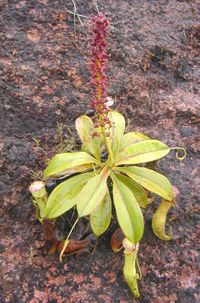نبات لاحم
النباتات آكلة اللحوم Carnivorous plants أي نبات يتصَّيد الحشرات من أجل الغذاء. ومثل هذه النباتات تسمَّى أيضًا النباتات آكلة اللحوم. ويعيش النبات آكل الحشرات عادة في الأماكن الرطبة حيث لا تعطي التربة إلا القليل من النيتروجين أو لا تعطي قط. وعلى النبات أن يحصل على النيتروجين من الحشرات التي يتصيدها. والنباتات آكلة الحشرات لها أعضاء خاصة تمسك بها الحشرات، وغدد تفرز سائلاً هاضمًا يساعدها على الإفادة من غذائها. وبعض النباتات آكلة الحشرات لها أزهار ملونة أو ذات رائحة تمكّنها من أن تَظْهر أو تشم من مسافة كاللحم المتعفن، مما يؤدي إلى اجتذاب الحشرات.
وتطور النباتات آكلة الحشرات خدعًا متعددة لتشكل مصايد. فنباتات النابنط مثلاً لها أوراق تشبه الحقاق وتحفظ ماء المطر لتغرق فيه الحشرات. وورديات الأوراق المزودة بشعرات لاصقة تكون محمولة على النبتة النديَّة، وحين تَعْلق حشرة بالشعرات، تلتف أطراف الأوراق حولها، وتصيدها. وشرك الذباب له أوراق تعمل مثل مصيدة فولاذية، إذ تُطبق الأوراق على الحشرة، وتمسك بها في الداخل.
. . . . . . . . . . . . . . . . . . . . . . . . . . . . . . . . . . . . . . . . . . . . . . . . . . . . . . . . . . . . . . . . . . . . . . . . . . . . . . . . . . . . . . . . . . . . . . . . . . . . . . . . . . . . . . . . . . . . . . . . . . . . . . . . . . . . . . . . . . . . . . . . . . . . . . . . . . . . . . . . . . . . . . . .
آليات الاصطياد
Five basic trapping mechanisms are found in carnivorous plants.
- Pitfall traps (pitcher plants) trap prey in a rolled leaf that contains a pool of digestive enzymes or bacteria.
- Flypaper traps use a sticky mucilage.
- Snap traps utilize rapid leaf movements.
- Bladder traps suck in prey with a bladder that generates an internal vacuum.
- Lobster-pot traps force prey to move towards a digestive organ with inward-pointing hairs.
Pitfall traps
Flypaper traps
Snap traps
Bladder traps
Lobster-pot traps
التطور
التصنيف
Dicots
- Asterales (sunflower and daisy order)
- Stylidiaceae
- Stylidium (trigger plants, a borderline carnivore)
- Stylidiaceae
- Caryophyllales, (carnation order)
- Dioncophyllaceae
- Drosophyllaceae
- Drosophyllum (Portuguese dewy pine)
- Droseraceae (sundew family)
- Nepenthaceae (tropical pitcher-plant family)
- Nepenthes (tropical pitcher plants or monkey-cups, including Anurosperma)
- Ericales (heather order)
- Roridulaceae
- Roridula (a borderline carnivore)
- Sarraceniaceae (trumpet pitcher family)
- †Archaeamphora
- Sarracenia (North American trumpet pitchers)
- Darlingtonia (cobra plant/lily)
- Heliamphora (sun or marsh pitchers)
- Roridulaceae
- Lamiales (mint order)
- Byblidaceae
- Lentibulariaceae (bladderwort family)
- Pinguicula (butterworts)
- Genlisea (corkscrew plant)
- Utricularia (bladderworts, including Polypompholyx, the fairy aprons or pink petticoats and Biovularia an obsolete genus)
- Martyniaceae (all borderline carnivores, related to the sesame plant)
- Oxalidales (wood sorrel order)
- Cephalotus (Albany pitcher plant)
. . . . . . . . . . . . . . . . . . . . . . . . . . . . . . . . . . . . . . . . . . . . . . . . . . . . . . . . . . . . . . . . . . . . . . . . . . . . . . . . . . . . . . . . . . . . . . . . . . . . . . . . . . . . . . . . . . . . . . . . . . . . . . . . . . . . . . . . . . . . . . . . . . . . . . . . . . . . . . . . . . . . . . . .
Monocots
- Poales (grass order)
- Bromeliaceae (bromeliad or pineapple family)
- Brocchinia (a terrestrial bromeliad)
- Catopsis (a borderline carnivore)
- Eriocaulaceae (pipewort family)
- Paepalanthus (a borderline carnivore)
- Bromeliaceae (bromeliad or pineapple family)
الزراعة
Although different species of carnivorous plants have different requirements in terms of sunlight, humidity, soil moisture, etc., there are commonalities.
انظر أيضًا
المصادر
للاستزادة
| Carnivorous plants
]].
- Slack A (1986). Insect-eating plants and how to grow them. Sherborne UK: Alphabooks. ISBN ISBN 0-906670-42-X.
{{cite book}}: Check|isbn=value: invalid character (help) - Juniper BE, Robins RJ, Joel DM (1989). The carnivorous plants. Academic Press, San Diego.
{{cite book}}: CS1 maint: multiple names: authors list (link) - Carnivorous Plant Database provides an up-to-date, searchable database of all the published species of carnivorous plants.
- Carnivorous Plant FAQ at Sarracenia.com
- List of films and TV shows that feature carnivorous plants-most of them fictional
- Botanical Society of America - Carnivorous Plants Online
- Ellison, A.M. 2006. Nutrient Limitation and Stoichiometry of Carnivorous Plants.PDF (334 KiB) Plant Biol. 8: 740–747.
